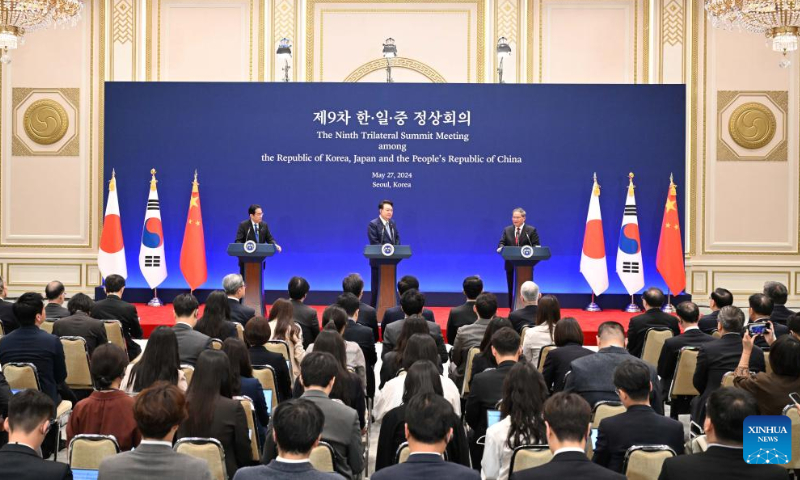Chinese Premier Li Qiang jointly meets the press with South Korean President Yoon Suk-yeol and Japanese Prime Minister Fumio Kishida following the ninth Trilateral Summit Meeting among China, Japan and South Korea, in Seoul, South Korea, May 27, 2024. Photo: Xinhua
The ninth Trilateral Summit Meeting among China, Japan and South Korea, held after more than four years, achieved significant progress and consensus in many areas. According to statements from the leaders of the three countries and the joint declaration issued after the meeting, China, Japan, and South Korea unanimously agreed to work together to implement the Trilateral Cooperation Vision for the Next Decade adopted at the eighth Trilateral Summit Meeting and promote the institutionalization of trilateral cooperation mechanisms among the three countries. The three parties will resume negotiations for a China-Japan-South Korea free trade agreement, strengthen supply chain cooperation, and continuously deepen collaboration in six key areas: culture, sustainable development, economy and trade, public health, science and technology, and disaster relief. During the meeting, Chinese Premier Li Qiang emphasized that the three sides should upgrade and speed up China-Japan-South Korea cooperation, embark on a new journey of comprehensive development and contribute more to regional prosperity and stability.
It should be said that, although some voices from the outside intentionally lowered expectations, the results and impact achieved in this meeting have been proven to be very significant. In addition to the aforementioned trilateral achievements, significant progress was made on a bilateral level as well. China and South Korea agreed to accelerate the second phase of their free trade agreement negotiations and establish a “2+2” diplomatic and security dialogue. China and Japan agreed to hold a new round of high-level economic dialogue and high-level people-to-people and cultural exchange consultation mechanism meetings at an appropriate time. All these are fruits borne within the framework of the trilateral leaders’ meeting between China, Japan, and South Korea. This meeting reflects the willingness of the three parties to develop relationship through practical cooperation, and embodies the characteristics of “fully activating existing cooperation and steadily nurturing new cooperation.” This prompted some American media to frankly admit that the summit reminded people that “US allies have their own interests to manage.”
It is evident that there are distinctly different attitudes toward this meeting. The Washington Post described the meeting as Beijing’s attempt “to counter Japan and South Korea’s closer ties with US.” Nikkei noted that the resumption of the dialogue among China, Japan, and South Korea came at a time when the three countries are facing common challenges, stating that “even as trade and geopolitical tensions rise between the US and China, Japan and South Korea are not in a position to sever economic ties with China.”
In fact, the starkly different attitudes between Washington and regional countries reflect a deeper issue of how to view trilateral cooperation between China, Japan, and South Korea. From a geopolitical perspective, especially against the backdrop of the US intensifying efforts to rally allies against China, this meeting serves more to stabilize bilateral and trilateral relationships. However, from the perspective of safeguarding the common interests of the three countries and addressing common challenges, this meeting demonstrates the strong foundation and vast potential for cooperation between China, Japan, and South Korea. It is from the latter perspective that this meeting timely reflects some overlooked but important realities in the current trilateral relationship, and provides an outlook on how to view future trilateral cooperation.
There is no need to deny that in the past four years, there have been many changes between China, Japan, and South Korea. Some are at economic level, such as trade that used to be more complementary becoming more competitive, while others are at the cognitive level, with some people viewing China more from a competitive rather than cooperative perspective, following the views of Washington. What is more important than the changes themselves is how to perceive these changes. Taking China and South Korea as an example, as China’s industrial competitiveness increases, it is a reality that competition between the two countries is strengthening. However, it is also important to recognize that there is still strong trade complementarity in areas such as electronics, new energy, and high-end manufacturing. If new rules arrangements are made through upgrading negotiations of free trade agreements for emerging industries in recent years, it will further expand the industrial cooperation between the two countries, continuously unleashing the dividends of China-South Korea economic and trade cooperation.
China, Japan, and South Korea, as neighboring countries that cannot be moved, are interdependent in terms of regional peace and stability, as well as economic development and prosperity. Despite the continuous actions and noises led by the US such as “decoupling” from China, building “small yard, high fence,” and “reducing dependence on China to ensure economic security,” China is the largest trading partner of Japan and South Korea, and Japan and South Korea are important trading partners of China. This basic pattern remains stable. China, Japan, and South Korea have revitalized the significant existing cooperation under the China-Japan-South Korea Free Trade Agreement, while also introducing new initiatives such as the “China-Japan-South Korea Innovation Cooperation Center” and the China-Japan-South Korea Cultural Exchange Year. The ability to activate existing cooperation and generate new initiatives stems from the inherent logic of internal demand. This reflects traditional cooperation needs that have been validated over many years and exhibit strong resilience. Meanwhile, the new initiatives demonstrate emerging trends that align with and adapt to the further requirements of trilateral cooperation.
As neighboring countries with a long shared history and great potential for cooperation in various fields in the future, China, Japan, and South Korea stand at a crucial point for the comprehensive restart of trilateral cooperation, making it particularly important to look toward the future. For the present moment, even in disagreements, there is still space to find consensus and cooperation. Looking toward the future, China, Japan, and South Korea are still opportunities for each other.
Global Times




